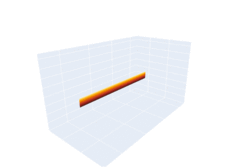Plate trick
In mathematics and physics, the plate trick, also known as Dirac's string trick (after Paul Dirac, who introduced and popularized it),[1][2] the belt trick, or the Balinese cup trick, is any of several demonstrations of the idea that rotating an object with strings attached to it by 360 degrees does not return the system to its original state, while a second rotation of 360 degrees, a total rotation of 720 degrees, does.[3] Mathematically, it is a demonstration of the theorem that SU(2) (which double-covers SO(3)) is simply connected. To say that SU(2) double-covers SO(3) essentially means that the unit quaternions represent the group of rotations twice over.[3] A detailed, intuitive, yet semi-formal articulation can be found in the article on tangloids.
Demonstrations
Resting a small plate flat on the palm, it is possible to perform two rotations of one's hand while keeping the plate upright. After the first rotation of the hand, the arm will be twisted, but after the second rotation it will end in the original position. To do this, the hand makes one rotation passing over the elbow, twisting the arm, and then another rotation passing under the elbow untwists it.[4][5]
In mathematical physics, the trick illustrates the quaternionic mathematics behind the spin of spinors.[6] As with the plate trick, these particles' spins return to their original state only after two full rotations, not after one.
The belt trick
The same phenomenon can be demonstrated using a leather belt with an ordinary frame buckle, whose prong serves as a pointer. The end opposite the buckle is clamped so it cannot move. The belt is extended without a twist and the buckle is kept horizontal while being turned clockwise one complete turn (360°), as evidenced by watching the prong. The belt will then appear twisted, and no maneuvering of the buckle that keeps it horizontal and pointed in the same direction can undo the twist. Obviously a 360° turn counterclockwise would undo the twist. The surprise element of the trick is that a second 360° turn in the clockwise direction, while apparently making the belt even more twisted, does allow the belt to be returned to its untwisted state by maneuvering the buckle under the clamped end while always keeping the buckle horizontal and pointed in the same direction.[7]
Mathematically, the belt serves as a record, as one moves along it, of how the buckle was transformed from its original position, with the belt untwisted, to its final rotated position. The clamped end always represents the null rotation. The trick demonstrates that a path in rotation space (SO(3)) that produces a 360 degree rotation is not homotopic to a null rotation, but a path that produces a double rotation (720°) is null-homotopic.[3]
Belt trick has been witnessed in 1-d Classical Heisenberg model as a breather solution.[8]
See also
References
- ↑ Staley, Mark (2010-01-12). "Understanding Quaternions and the Dirac Belt Trick". arXiv:1001.1778 [physics.pop-ph].
- ↑ Schiller, Christoph (2021-01-13). "Testing a conjecture on the origin of the standard model" (in en). The European Physical Journal Plus 136 (1): 79. doi:10.1140/epjp/s13360-020-01046-8. ISSN 2190-5444. https://doi.org/10.1140/epjp/s13360-020-01046-8.
- ↑ Jump up to: 3.0 3.1 3.2 Staley, Mark (May 2010). "Understanding Quaternions and the Dirac Belt Trick". European Journal of Physics 31 (3): 467–478. doi:10.1088/0143-0807/31/3/004. Bibcode: 2010EJPh...31..467S.
- ↑ Leonard Susskind. "Advanced Quantum Mechanics, Lecture 5, time point 51:53". https://www.youtube.com/watch?v=A7PZftS7uOA&list=PL7Yaf7nQHP3B591m111lySw_FSqRTAbrj&index=5.
- ↑ "Actor Performs the Plate Trick". http://ariwatch.com/VS/Algorithms/PlateTrick.htm.
- ↑ Charlie Wood (6 Sep 2018). "The Strange Numbers That Birthed Modern Algebra". Quanta Magazine. https://www.quantamagazine.org/the-strange-numbers-that-birthed-modern-algebra-20180906/.
- ↑ "Dirac Belt Trick". http://virtualmathmuseum.org/Surface/dirac-belt/DiracBelt.html.
- ↑ Rahul, O. R.; Murugesh, S. (2019-05-01). "Rogue breather modes: Topological sectors, and the 'belt-trick', in a one-dimensional ferromagnetic spin chain" (in en). Chaos, Solitons & Fractals 122: 262–269. doi:10.1016/j.chaos.2019.02.012. ISSN 0960-0779. https://www.sciencedirect.com/science/article/pii/S0960077919300736.
- Bolker, Ethan D. (November 1973). "The Spinor Spanner". The American Mathematical Monthly 80 (9): 977–984. doi:10.2307/2318771.
- Pengelley, David; Ramras, Daniel (2017-02-21). "How Efficiently Can One Untangle a Double-Twist? Waving is Believing!" (in en). The Mathematical Intelligencer 39: 27–40. doi:10.1007/s00283-016-9690-x. ISSN 0343-6993.
External links
- Animation of the Dirac belt trick, including the path through SU(2)
- Animation of the Dirac belt trick, with a double belt
- Animation of the extended Dirac belt trick, showing that spin 1/2 particles are fermions: they can be untangled after switching particle positions twice, but not once
- Mechanical linkage implementing the belt trick
- Air on the Dirac Strings, showing the belt trick with several belts attached to a spherical particle, by Louis Kauffman and colleagues
- Video of Balinese cup trick
- The Dirac String Trick
- The double-tipping nullhomotopy
 |



